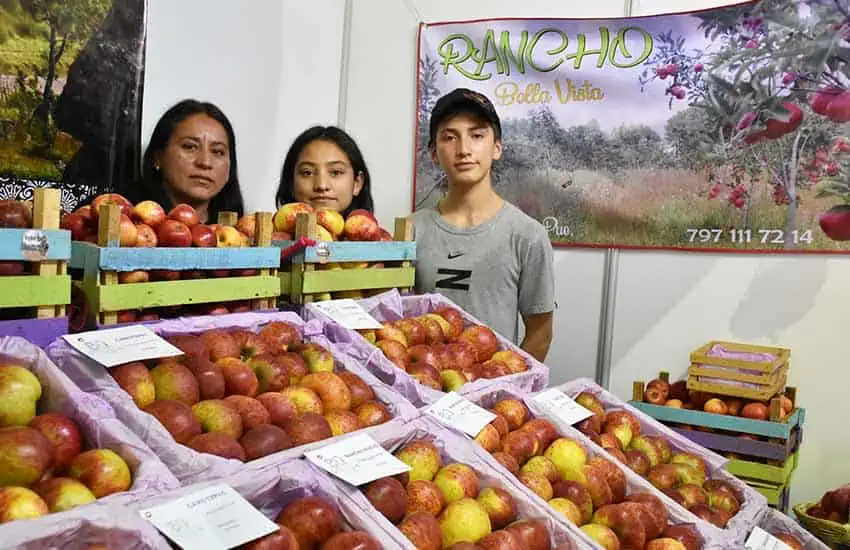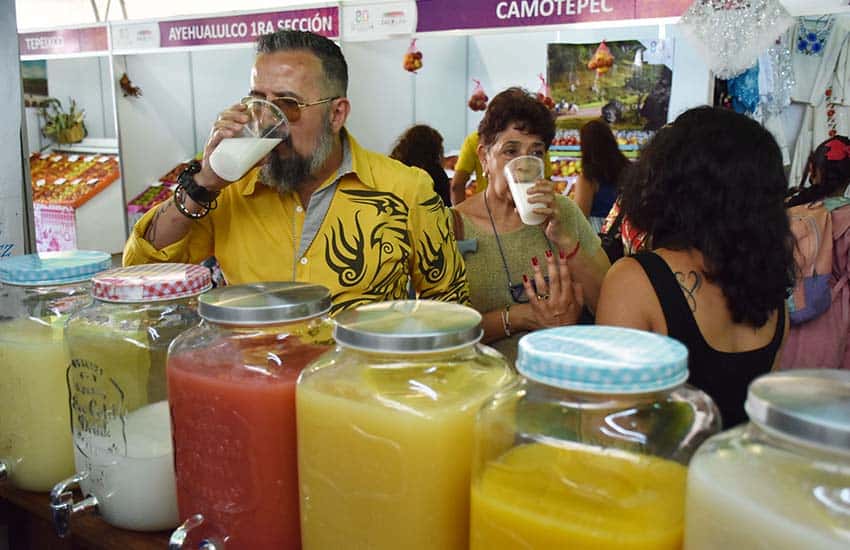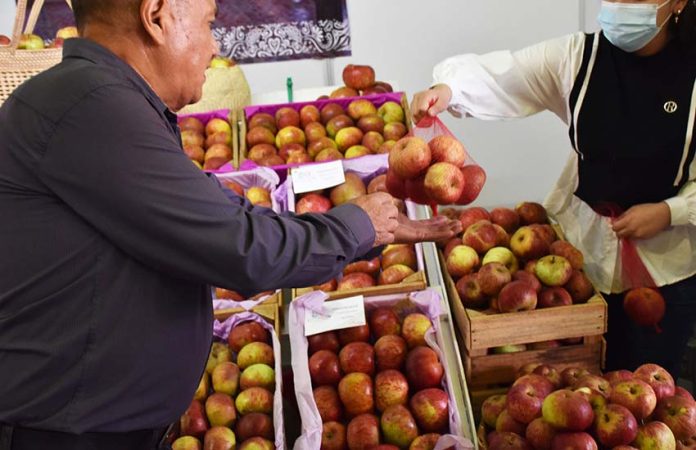If you like eating apples, then Zacatlán de las Manzanas, Puebla, whose name means Zacatlan of the Apples, is the place for you. And the Feria de la Manzana apple fair is the absolute best time of year to visit.
The fair, which began in 1941, has been held every year since, except for 2020 and 2021, when it was shut down due to the pandemic. It coincides with the apple harvest in Puebla, which typically begins in the end of July and lasts until around the end of August.
The fair made news this year due to a planned addition to the schedule of bullfights, which ended up being canceled after residents protested. But the apple festival — the most important annual event in Zacatlán — is about celebrating Puebla’s harvest with numerous stands filled with apples and other related products. It also features concerts, dances and exhibits.
This year, a long tent located just off the zócalo housed farmers showcasing their apples and vendors a variety of other products. Also under the tent were stands packed with delicious foods and desserts made with apples.

La Casa de Manzana, as well as many other stands and bakeries, featured manzana hojaldrada, a traditional puff pastry with a whole apple inside. Originally, it was just a cored apple.
“Inside it can have blueberry, cream cheese, blackberries, walnuts or raisins,” vendor Angeles Moreno Ramírez explained. The medium-sweet Rayada variety is the apple of choice for these pastries.
Judith Rojas Cruz of Panaderia Betos bakery was selling small apple pies, apple muffins and the pueblo’s famous pan de Zacatlán at an adjacent stand. “There are two kinds,” she said. “There are burras and pan almohada.” She uses different doughs for them, and the tops of the burras are sprinkled with sesame seeds. Both are stuffed with queso ranchero.
Just outside the tent, Jeanete Pérez Hernández was tempting fairgoers with various apple desserts: cheesecake, bread, flan and empanadas. “All of these use Rayada apples because they are more acidic and juicier, not so sweet,” she said. “The other apples do not work as well.”
Walking through the fair and around Zacatlán’s streets can work up a thirst, and one stand offered a traditional way to quench it: pulque, a traditional fermented Mexican alcoholic beverage.
“More than 50% of the land in Zacatlán is used to grow agave to make pulque,” Rafael Amador Marquéz told me. He’s part of a fourth generation of pulque makers at Rancho Tepemayuca. At the fair, he was offering plain pulque and a number of curados, made with pulque and fruit or other flavors.
“Coco is my favorite,” said Francisco Arias who had stopped by for a drink, adding, “I come to the fair for the apples, the pastries and the pulque.”
Amador also sold something that’s relatively new: distilled pulque. “It takes 10 liters of pulque to make one liter of distilled,” he said. “First, the pulque is fermented for three months in French oak barrels, and then it is distilled.”
While pulque is usually 2% to 4% alcohol, the distilled version is 38% alcohol. “More time yields more alcohol,” he said simply.
Amador also offers a tour called La Ruta del Pulque that takes people to visit agave growers and shows them how pulque is made.
Walking through the fair works up an appetite, and besides pastry, the best way to satisfy your hunger is with one of Puebla’s most famous dishes: chiles en nogada, a poblano chile stuffed with 11 ingredients, including meat, fruit and nuts. It’s smothered in a salsa made with walnuts and topped with parsley and pomegranate seeds, making it a seasonal dish.
“The season for chile en nogada is July 1 to the end of September,” said Mari Luz Martínez Barrios, chef at Dos Aromas restaurant. “Here in Zacatlán, [we have] all the ingredients needed.”

That includes Rayada apples, which Martínez prefers because of their consistency.
Although she kindly demonstrated the process for making her chiles en nogada, she begged off giving an exact recipe.
“It is a secret,” she said. “Even if you had it, you would not know how to make it because you do not have all the flavorings.”
But despite all the tasty food and beverages here, the real stars of the feria are, of course, the apples.
Zacatlán can grow 18 types of apples, according to Irma Ortega Ibarra, who along with her husband Jesús Garrido León owns Bella Vista farm. She stood with her children behind a wooden stand holding their three types of apples for sale: Rayada, Gala and Delicia.
“The sweetest is the Gala, and that can be used for juices and salads,” she said. “Rayada is acidic and is used for baking and breads, and Delicia is medium; it is used for wines and sidra (hard cider). Here it is good for growing apples because it is humid,” she explained. “There is much rain, and, in general, there is no need for watering.”
Their farm has been in the family for five generations, Ortega said, and she and her husband plan to pass it on to their children, who seem eager.
“I want to continue [growing apples] because it is enjoyable to be in nature,” said their son Jesús Enrique Garnido Ortega. “I want to continue with a healthy farm.”
Daughter Anete Garnido Ortega plans to learn how to make sidra (hard cider).
Their plans, however, may be challenged in the years to come: although the family had a good harvest this year, climate change has been affecting the apples, they said.
Luciano Cabrera Luna — whose 15-hectare farm (38 acres) in the nearby pueblo of Jicolapa was one of the largest ones attending the fair — also attributes changes she’s noticed in her apples to climate change. “The fruit doesn’t develop adequately,” she said. “If it rains, more of the fruit are large, but now there is less rain and the apples are smaller.”
This year, she planted lima beans, but they didn’t even grow due to a lack of rain.
“It does not rain like before, and if there is a drought, the fruit does not develop,” she said. “Sometimes we have to irrigate each tree, carrying buckets of water to them.” They have to plant new trees every year, Cabrera said.
This year, however, there are plenty of freshly harvested apples still available in Zacatlán, even though the fair has ended. You can find apple stands lining the main road leading into town, and a dozen pickup trucks laden with apples park near the corner of Francisco Cosio and Hermanegido Galeana streets, just a few blocks from the zócalo.
And if you need more of an excuse than apples to make the drive, Zacatlán is one of Mexico’s Pueblos Mágicos and worth a trip any time of year: visit the clock museum, the wine museum, a 16th-century church and ex-convent and a beautiful zócalo ringed with shops, restaurants and coffee shops. A short drive away is Cascadas Tulimán, an ecotourism site with a beautiful waterfall and scenery and paths.
Joseph Sorrentino, a writer, photographer and author of the book San Gregorio Atlapulco: Cosmvisiones and of Stinky Island Tales: Some Stories from an Italian-American Childhood, is a regular contributor to Mexico News Daily. More examples of his photographs and links to other articles may be found at www.sorrentinophotography.com He currently lives in Chipilo, Puebla.
